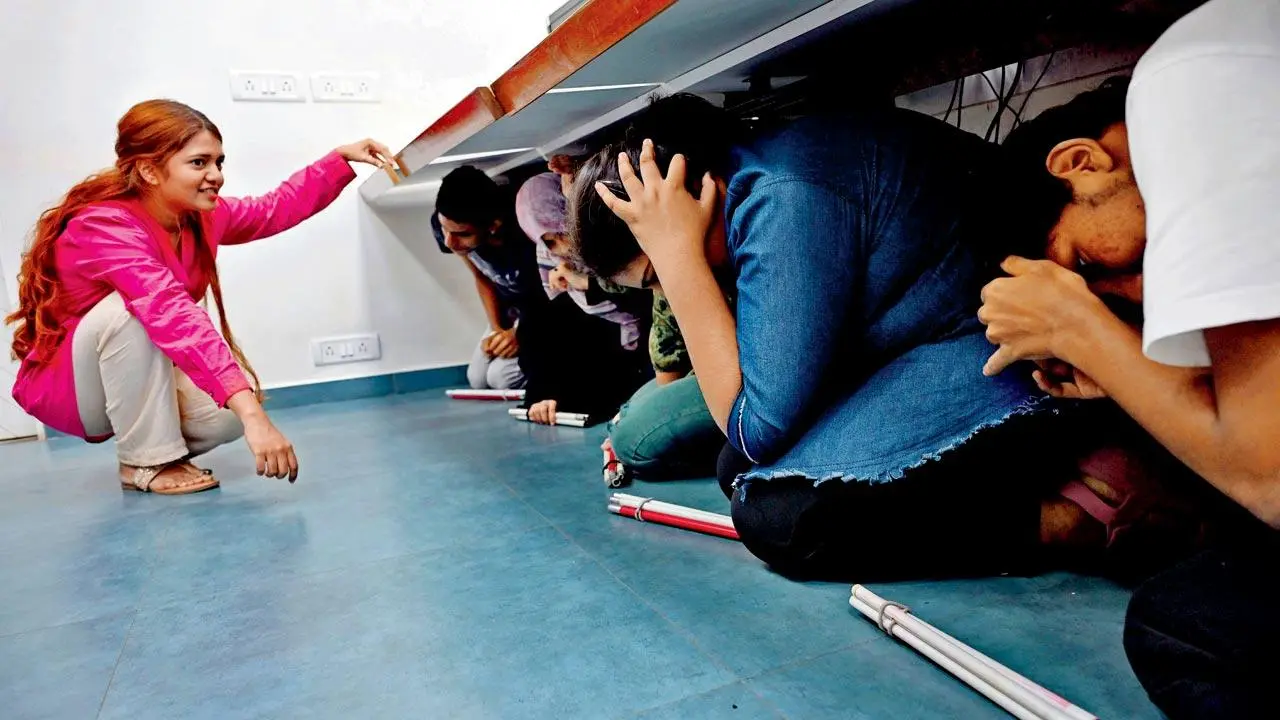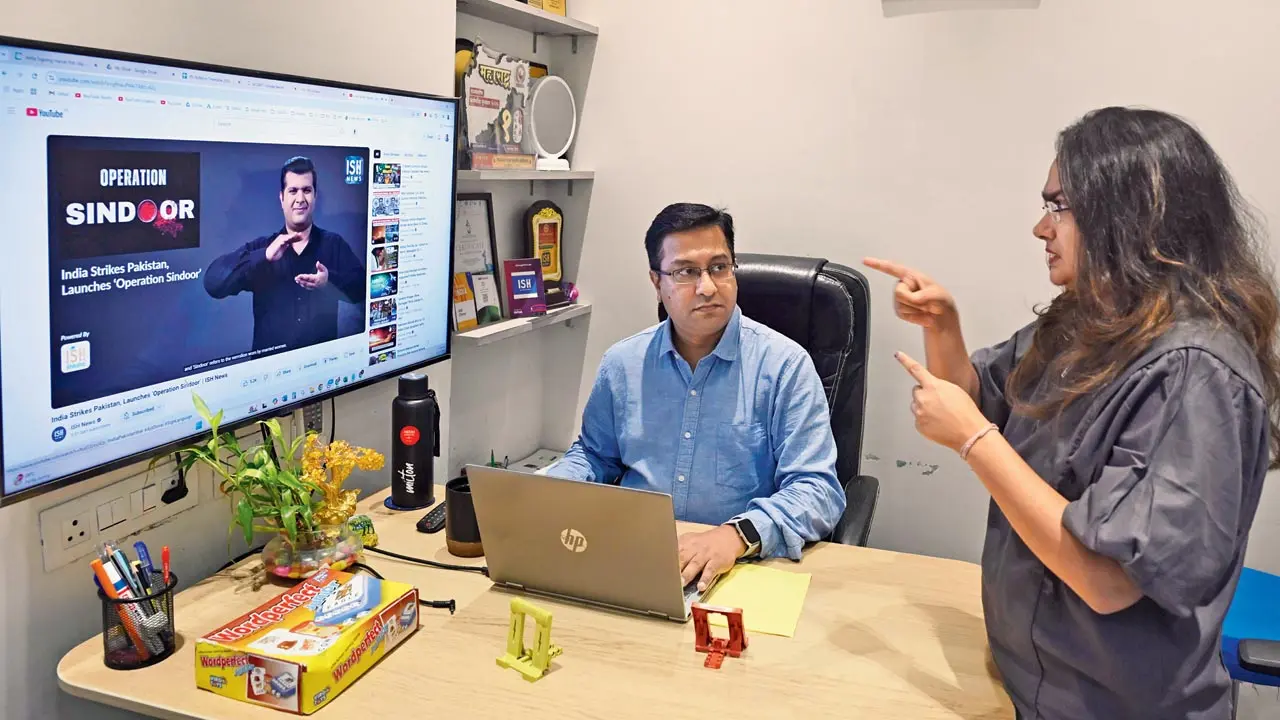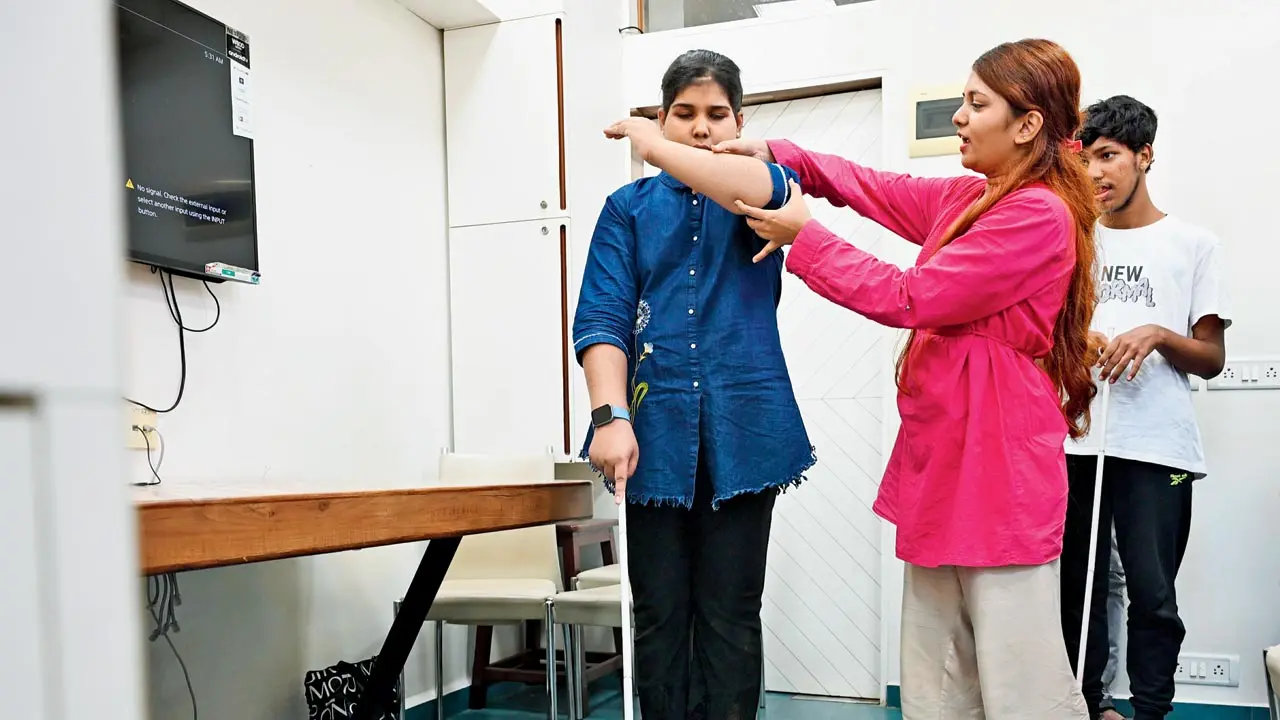Thankfully, we now have a ceasefire. This gives us the opportunity to ensure we are better prepared to empower persons with disabilities with protocols for future emergencies. A few city organisations are already laying the groundwork

Shizanne D’mello trains students of Xavier’s Resource Centre for the Visually Challenged, located at St Xavier’s College in Fort, on how to take shelter under tables in case of an air raid. Pics/Kirti Surve Parade
While most of us have been feeling helpless in the past week, trying to sift through all the misinformation amid the tension between India and Pakistan online, it has been an even more confusing time for the Deaf and Blind. In the absence of an official SOP for what persons with disabilities should do when the sirens blare or a blackout is declared, city organisations have quietly been stepping up to empower them with practical protocols and training, without sparking panic.
What should a Blind person do if, for instance, the sirens go off while they are out and about in an unfamiliar place?
“Duck under, cover and shielding your face,” says Shizanne D’mello, senior coordinator, Education, at the Xavier’s Resource Centre for the Visually Challenged (XRCVC), St Xavier’s College, Fort. “Make sure to cover your face when you tuck and roll, so you don’t hit something on your way down to the ground when the sirens go off,” she tells five novice Blind students who are at the institute for a training session on Friday. Another tells us D’ mello is — to find and tag along with a sighted guide, who can provide visual instructions.
 Swayam Dedhia and Inshirah Chouhan
Swayam Dedhia and Inshirah Chouhan
For the five of them, this is their very first Orientation and Mobility class. D’mello explains that none of them have had formal training on how to go about in this world, without any help. “Most of them will now go into college and we are preparing them to move around safely,” she says.
Training at the institute was on as usual — how to navigate traffic, sidewalks, obstructions, and more — until Thursday night, when the tensions flared up further with the neighbouring country reportedly launching drone attacks on Indian cities near the border. “I came upon some drill videos on social media and realised that we needed to pass on this information to the students attending classes at the centre,” D’mello adds. And that is exactly what she did, putting together available information and merging it with already existing SOPs to help the students feel prepared. The “duck and roll” move, as well as the act of switching the lights off (for blackouts) is drilled into them until it becomes muscle memory and shortens their response time in case of an air raid..
Ketan Kothari, managing consultant with the institute, has an unexpected take on the situation. There may be no SOPs in place for the Blind, but he believes that they are relatively better off than the Deaf, and evenly matched with the abled. “I think if an air raid does happen, the visually disabled and the abled will be on equal footing when it comes to the lack of information on what to do since there is no material for them as well. When out in the open during an air raid,” he says, “Where will the sighted go? If on the road, they too will take cover and duck, just like us. There are no SOPs for us, nor for anyone else.”
 An ISH News anchor signs for a news video recording
An ISH News anchor signs for a news video recording
Swayam Dedhia, 16, is one of the five students being coached by D’mello on Friday afternoon. The students look alert, but not alarmed; information and preparation are helping build their confidence. “We’ve been taught to switch off the lights if the sirens blast, go under the table and lie on our stomach in case there is actual danger. We have also been trained to cover our ears so that our eardrums don’t rip. Finally, we have also been taught to stuff our mouths with cloth so we don’t scream in panic,” says the teen matter-of-factly.
Dedhia’s classmate Inshirah Chouhan seems just as smart and tough. “If we face an actual raid and panic because we can’t identify where we are,” Chouhan says, “we have been asked to take the help of a sighted person. We have learned self-reliant techniques as well — we are to run away from the noise, find a corner and hide. If at home, we can take the help of family members and take refuge under tables.”
Relying on a buddy system, or packing a go bag with essentials for quick escape are tips that one would assume anyone can find online with a cursory search, but for many persons with disabilities this information is not as easily accessible. How many sign language videos have you seen explaining what to do in the preparatory drill that took place on May 7? How many Reels on the conflict are accompanied by an audio description and closed captions?
 Aqil Chinoy and Mansi Shah discuss ISH News’s sign-language video disseminating information on Operation Sindoor, and dos and don’ts. Pic/Ashish Raje
Aqil Chinoy and Mansi Shah discuss ISH News’s sign-language video disseminating information on Operation Sindoor, and dos and don’ts. Pic/Ashish Raje
Without information or SOPs in place to help them, persons with disabilities face additional challenges not just in times of conflict, but also in emergencies such as pandemics, and natural disasters.
In 2013, the UN Office for Disaster Risk Reduction conducted a global survey of persons living with disabilities on how they cope with disasters. From the flood-prone Thailand to the fire- and hurricane-prone US, among other countries, only 20 per cent disabled people said they could evacuate immediately without difficulty. With sufficient time provided, this percentage rose to 38 per cent, which shows just how important disabled-friendly early warning systems are to improve reaction time.
In Ukraine and Gaza, for example, Deaf citizens have to rely on their family members or apps on their devices to alert them to an incoming air raid, as they can’t hear the sirens. Closer to home, in Mumbai, some organisations have had the foresight to arm persons with disability with information and emergency plans. Many persons with disabilities have now come to rely on these agencies as trusted sources of information in a world that so easily forgets about them.

XRCVC students receive training on navigate public spaces safely
One of these organisations is the Andheri-based Access For All, which audits inclusive infrastructure and digital accessibility in schools, corporates and the hospitality industry. It has released a handy guide with inclusive safety and evacuation instructions for persons with disabilities in emergencies.
Founder Siddhant Shah started the initiative due to the challenges faced by his visually impaired mother. “The guide includes what to pack in a go bag; it changes depending on whether the person has visual or hearing impairment. The former needs to pack an extra cane and the latter must carry extra hearing aids, if they use any,” explains Shah.
Shah’s aptly named guide — How inclusive and accessible is your evacuation mock drill? — has inputs for the Deaf like visual cue cards and signs for common phrases that they can use to communicate with hearing people. For the Blind, there are tips such as carrying vibrating devices for alerts, a pre-recorded audio list of emergency contacts, a talking watch and a tactile map of the house. The guide also recommends that visually challenged people practice exit routes with a family member.
The organisation has also asked corporates and hotels that employ persons with disability to install strobe lights or blue flashing lights to alert their Deaf employees during emergencies.
Shah, who is also a consultant for schools with neurodivergent students, found that during the May 7 drills, many of the children had an adverse reaction to the noise or the flashing lights. “Many neurodivergent children cannot deal with extremely high-decibel sounds or strobe lights, because of which they froze in fear. We are trying to find a more suitable way to empower them,” he adds.
In the Lower Parel studio of Indian Sign Hand (ISH) News, a man stands against a green screen and vigorously signs to a camera with animated expressions. The end product? A video for their YouTube channel that explains what to do in case of an air raid.
The news initiative, founded in 2017 by Alok Kejriwal, has a team of two that run the day-to-day operations; Aqil Chinoy heads the IT department and Mansi Shah is the interpreter. With over five lakh subscribers, the channel’s audience swelled during the COVID pandemic, thanks to its life-saving informative videos at the time.
The organisation is once again proving itself as a buoy of hope in the middle of another crisis. On WhatsApp video call, Chinoy signs to us — as Shah interprets — insisting on using the word Deaf to refer to the community.
“When we were told that a siren would be used in order to inform the general public of an impending raid, I became concerned because I would not be able to hear it,” says Chinoy.
This feeling of being on the backfoot, fuelled by a lack of information that is inclusive, led ISH News to translate government-provided updates and advice on dos and don’ts into sign language videos. The drill video uploaded on May 7, the day of the drills, has 3000 likes but it is the comments that stand out to us. One comment reads, “Thank you so much for sharing in sign language. My sister and her husband are both mute and Deaf. They live alone in Bhuj and I was unable to make them understand this situation of war and mock drills. I found your video and sent this to them.”
Chinoy’s wife and parents are Deaf as well, while his son, 8, and daughter, 14, are hearing. “The work we do is very important because just like in my home, there are many adults [in the family] who are Deaf. It is essential for us to be fully aware and on alert, we can’t just wait for information to trickle down to us,” he adds.
Asked about the lack of SOPs for persons with disabilities during emergencies, Chinoy is not unkind: “I understand that right now, the government is busy with the current situation, but I wish that proper SOPs accessible for the Deaf should be thought and implemented in advance,” he adds.
What other countries do
. The Palestinian Federation of the Deaf provides information to the Deaf in sign language via WhatsApp groups, and they are also provided high-visibility vests so soldiers can identify them as hearing-impaired
. In Ukraine, an estimated 36,000 Deaf citizens rely on text alerts of air raids as they cannot hear sirens
. In both countries, smartwatches have been effectively used by Deaf and Blind people to receive alerts of attacks, as well as inform loved ones that they are alive. The same technology is also used in the US to help the hearing-impaired stay informed in case of disasters
Get in Touch
. Access For All Email reachaccessforall@gmail.com
to get the guide Call on
+91 99207 65777
https://www.accessforall.co
. Xavier’s Resource Centre for the Visually Challenged
+91-22-35223298
35223300 35223301
35223299
xrcvc.org; Instagram: @xrcvc_mumbai
. Indian Sign Language (ISH) News
+91 7208684826
indiasigninghands.com
YouTube: @ISHNews
 Subscribe today by clicking the link and stay updated with the latest news!" Click here!
Subscribe today by clicking the link and stay updated with the latest news!" Click here!








